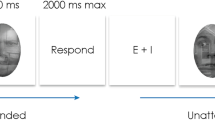Abstract
According to the New Look theory, size perception is affected by emotional factors. Although previous studies have attempted to explain the effects of both emotion and motivation on size perception, they have failed to identify the underlying mechanisms. This study aimed to investigate the underlying mechanisms of size perception by applying attention toward facial expressions using the Ebbinghaus illusion as a measurement tool. The participants, female university students, were asked to judge the size of a target stimulus relative to the size of facial expressions (i.e., happy, angry, and neutral) surrounding the target. The results revealed that the participants perceived angry and neutral faces to be larger than happy faces. This finding indicates that individuals pay closer attention to neutral and angry faces than happy ones. These results suggest that the mechanisms underlying size perception involve cognitive processes that focus attention toward relevant stimuli and block out irrelevant stimuli.


Similar content being viewed by others
References
Beck, A. T., Ward, C. H., Mendelson, M., Mock, J., & Erbaugh, J. (1961). An inventory for measuring depression. Archives of General Psychiatry, 4, 561–571.
Bradley, B. P., Mogg, K., Millar, N., Bonham-Carter, C., Fergusson, E., Jenkins, J., & Parr, M. (1997). Attentional bias for emotional faces. Cognition and Emotion, 11, 25–42.
Brendl, C. M., Markman, A. B., & Messner, C. (2003). The devaluation effect: Activating a need devalues unrelated objects. Journal of Consumer Research, 29, 463–473.
Bruner, J. S., & Danilova, M. V. (1947). Value and need as organizing factors in perception. Journal of Abnormal and Social Psychology, 42, 33–44.
Bruner, J. S., & Postman, L. (1948). Symbolic value as an organizing factor in perception. Journal of Social Psychology, 27, 203–208.
Cannon, W. B. (1929). Bodily changes in pain, hunger, fear, and rage. New York: Littleton.
Coren, S. (1971). A size contrast illusion without physical size difference. American Journal of Psychology, 84, 565–566.
Coren, S., & Enns, J. T. (1993). Size contrast as a function of conceptual similarity between test and inducers. Perception and Psychophysics, 54, 579–588.
Coren, S., & Girgus, J. S. (1978). Seeing is deceiving: The psychology of visual illusions. Hillsdale: Lawrence Erlbaum Associates.
Eastwood, J. D., Smilek, D., & Merikle, P. M. (2003). Negative facial expression captures attention and disrupts performance. Attention, Perception, & Psychophysics, 65, 352–358.
Ekman, P. (1982). Emotion in the human face (2nd ed.). Cambridge: University of Cambridge Press.
Elliot, A. J. (2006). The hierarchical model of approach-avoidance motivation. Motivation and Emotion, 30, 111–116.
Esteves, F., Dimberg, U., & Öhman, A. (1994). Automatically elicited fear: Conditioned skin conductance responses to masked facial expressions. Cognition and Emotion, 9, 99–108.
Gable, P. A., & Harmon-Jones, E. (2010). The effect of low versus high approach-motivated positive affect on memory for peripherally versus centrally presented information. Emotion, 10, 599–603.
Izard, C. E., & Bartlett, E. S. (1972). Patterns of emotions: A new analysis of anxiety and depression. Oxford: Academic Press.
Juth, P., Lundqvist, D., Karlsson, A., & Ohman, A. (2005). Looking for foes and friends: Perceptual and emotional factors when finding a face in the crowd. Emotion, 5, 379–395.
Knutson, B. (1996). Facial expressions of emotion influence interpersonal trait inferences. Journal of Nonverbal Behavior, 20, 165–182.
Lee, T. H., Lee, K., Lee, K. Y., Choi, J. S., & Kim, H. T. (2006). Korea University facial expression collection: KUFEC. Seoul: Lab of Behavioral Neuroscience, Department of Psychology, Korea University.
Parrot, W. G., & Hertel, P. (1999). Research methods in cognition and emotion. In T. Dalgleish & M. Power (Eds.), Handbook of cognition and emotion (pp. 61–81). New York: John Wiley & Sons Ltd.
Pinkham, A. E., Griffin, M., Baron, R., Sasson, N. J., & Gur, R. C. (2010). The face in the crowd effect: Anger superiority when using real faces and multiple identities. Emotion, 10, 141.
Planalp, S., DeFrancisco, V. L., & Rutherford, D. (1996). Varieties of cues to emotion in naturally occurring situations. Cognition and Emotion, 10, 137–153.
Plutchik, R. A. (1980). Emotion: A psychoevolutionary synthesis. New York: Harper & Row.
Proffitt, D. A., Stefanucci, J., Banton, T., & Epstein, W. (2003). The role of effort in perceiving distance. Psychological Science, 14(2), 106–112.
Roskos-Ewoldsen, D. R., & Fazio, R. H. (1992). On the orienting value of attitudes: Attitude accessibility as a determinant of an object’s attraction of visual attention. Journal of Personality and Social Psychology, 63, 198–211.
Spielberger, C. D., Gorsuch, R. L., & Lushene, R. E. (1970). Manual for the State-Trait Anxiety Inventory. Palo Alto: Consulting Psychologists Press.
Stapel, D. A., & Koomen, W. (1997). Social categorization and perceptual judgment of size: When perception is social. Journal of Personality and Social Psychology, 73, 1177–1190.
van Ulzen, N. R., Semin, G. R., Oudejans, R. R. D., & Beek, P. J. (2008). Affective stimulus properties influence size perception and the Ebbinghaus illusion. Psychological Research, 72, 304–310.
Veltkamp, M., Aarts, H., & Custers, R. (2008). Perception in the service of goal pursuit: Motivation to attain goals enhances the perceived size of goal-instrumental objects. Social Cognition, 26, 720–736.
Watson, D., & Friend, R. (1969). Measurement of social-evaluative anxiety. Journal of Consulting and Clinical Psychology, 33, 448–457.
Author information
Authors and Affiliations
Corresponding author
Rights and permissions
About this article
Cite this article
Choi, JW., Kim, K. & Lee, JH. The influence of attention toward facial expressions on size perception. Psychological Research 80, 69–75 (2016). https://doi.org/10.1007/s00426-014-0640-y
Received:
Accepted:
Published:
Issue Date:
DOI: https://doi.org/10.1007/s00426-014-0640-y




